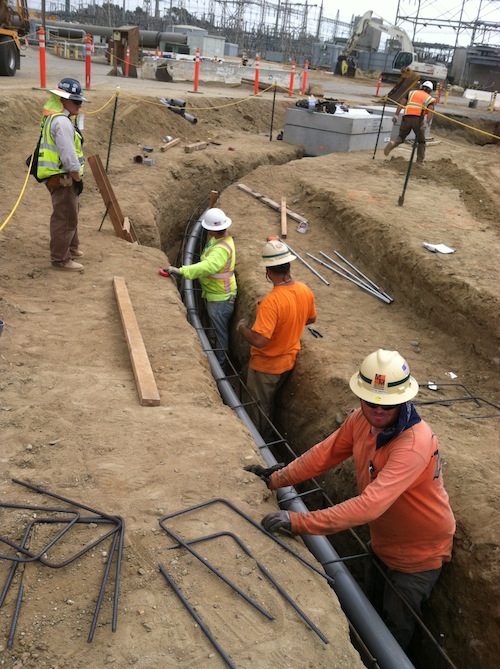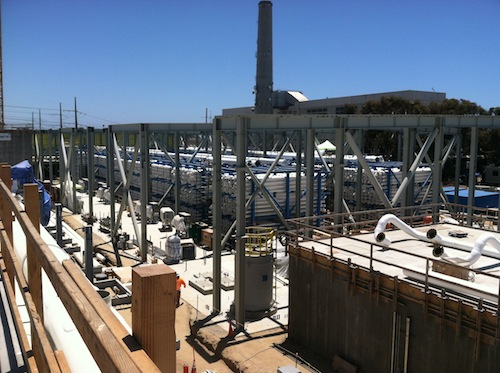In most parts of the U.S., we never think about running out of water. We wash our cars, water our lawns and take long showers, considering H20 to be infinite and dependable. Not so in California. With a growing population, wide sections of desert terrain and often high temperatures, sizeable slices of the state face dangerous droughts.
The San Diego Water Authority, serving 3 million residents, currently imports water from the Metropolitan District of Los Angeles. But while the Metropolitan District is the largest water treatment operation in the U.S., San Diego is looking to hedge against the growing scarcity by converting seawater into drinking water.
A $1 billion desalination plant and pipeline is taking shape in Carlsbad. When completed in the last quarter of 2015, it will be the largest seawater desalination plant in the Western Hemisphere. And 45 IBEW electricians, members of San Diego Local 569, are making it happen.
A public-private partnership between the authority and Poseidon Water, a Boston-based company, is financing the construction of the plant, designed by an Israel-based firm and expected to supply between 7 and 10 percent of the county’s water by 2020.
 |
| 12-year member Joe Loza says some apprentices on the Carlsbad Desalination Project are confronting new aspects of the trade, like underground piping and installing programmable logic controllers. |
The desalination plant will convert 54 million gallons a day of seawater into freshwater, operating on reverse osmosis, the same process used in some home water treatment systems. Salt and most biological and organic chemical compounds will be removed as seawater is pushed through 16,000 semi-permeable membranes by high pressure pumps installed by IBEW members.
“I have no doubt that this plant will be successful,” says Brian Murdick, a senior project manager for signatory electrical contractor Morrow-Meadows. The project is challenging, he says, because the design process was still incomplete as construction began.
Murdick’s charge is to efficiently and safely bring power to the project and install the massive pumps and technology that will make it a world leader in desalination.
Intake pumps are 2100 horsepower, 5 KV. High-pressure reverse osmosis pumps are 8000 horsepower, 15KV. A soft starter for the pump motor reduces the current drawdown when pumps are turned on.
Murdick says the process of reverse osmosis results in water exiting the plant that is actually “too clean.” Chemicals must be added back to keep the water to protect the concrete tanks and concrete-lined10-mile, 54-inch-diameter pipeline that will connect to an existing aqueduct pipeline system. He says his crews are as fascinated as he is with the technologies they are installing.
“This is the highlight of my career,” says 15-year Local 569 member Paul Fieweger, who is working on the desalination detail after spending most of his time building commercial structures, offices and schools. “I have to be on my ‘A game’ here,” says Fieweger who, before the desalination plant, had scant experience working on large industrial plants or using rigid conduit. “Most of the IBEW members want to be here and we are excited to be part of the project. And the IBEW’s caliber, our training and safety consciousness, is suited for this type of work.”
Joe Loza, a 12-year IBEW member, says the desal plant is his first large industrial project. “This is the best job I’ve ever had. The guys like working here and apprentices are being acquainted with a broad scope of construction from underground pipe to Ocal,® PVC-coated conduit, programmable logic controllers and 15,000-volt pumps,” says Loza.
A front-page story in Engineering News-Record details the importance of the Carlsbad plant which will produce 25 times the desalinated water of all 12 of the state’s existing plants combined.
 |
| Pumps installed by IBEW members push seawater through 16,000 reverse-osmosis membranes to produce water suitable for drinking, bathing and other needs. |
“If the project falters, the growing momentum for similar U.S. seawater desalination projects could face a reversal, industry observers say,” says ENR.
Rob Meadows, executive vice president of Morrow-Meadows, said he is confident that not only will Carlsbad not falter; it will be a template for others to follow.
“Rarely do our employees get the opportunity to work on such an important and challenging project as the desalination plant. Our IBEW crew has found the unique aspects of this installation both challenging and refreshing,” says Meadows. The methods and materials and technology used on this facility, he says are rarely used in San Diego, “yet our team has performed exceptionally well embracing the quality installation required along with an outstanding can-do attitude. Morale has been excellent throughout the project.”
The desal plant is located adjacent to the Encina gas-fired power station and will draw seawater from a 388-acre lagoon that supplies the power station with cooling water.
A portion of the diverted water from the Encina plant, staffed by members of San Diego Local 465, will, once desalinated, head into the water authority’s drinking-water system for further treatment. Another portion of high-saline water, or brine, will be diluted in the power plant discharge and returned to the ocean.
While the immediate cost of desalinated water will be higher than the current importation charge from the Metropolitan Water District, San Diego expects desalination to pay off in the long run as climate change and other forces impact water stability.